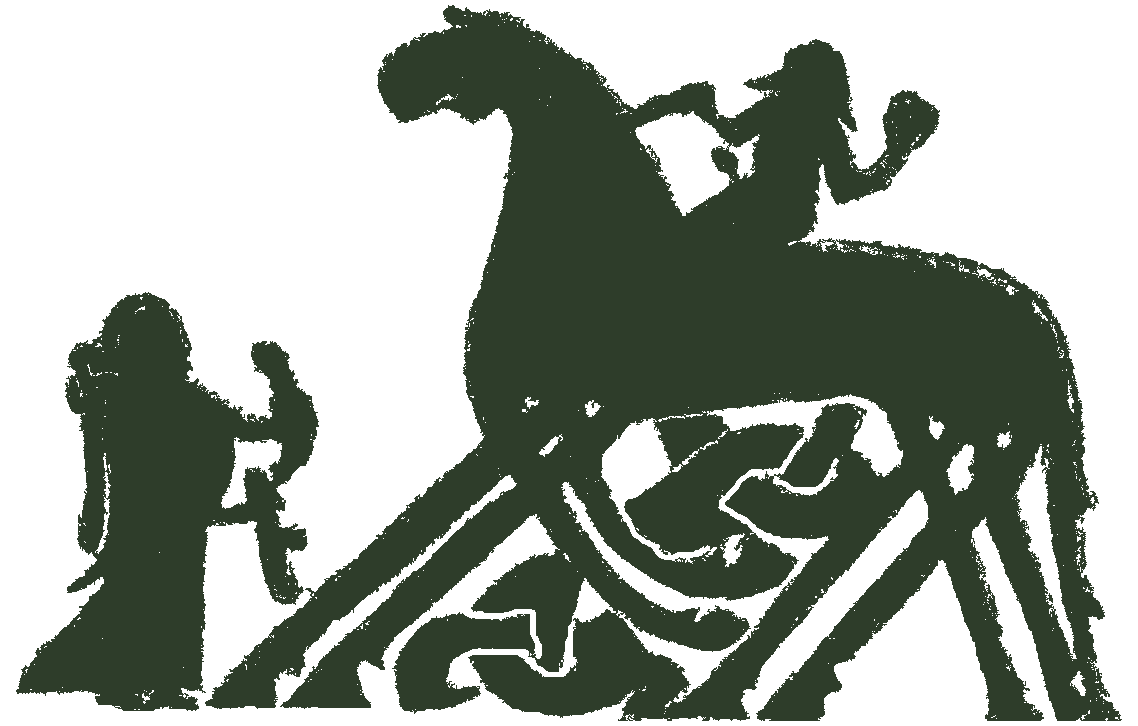Sveinn
description
Sveinn Úlfsson, son of Úlfr Þorgilsson, Dan. king (r. 1047-74) -- ÞjóðA Magnfl 5/3, 17/4, 18/4, ÞjóðA Magn 2/1, 3/6, 7/2, 12/8, 13/6, ÞjóðA Sex 12/1, 17/4, 18/1, ÞjóðA Har 7/6, Arn Magndr 15/1, Arn Hardr 4/1, Bõlv Hardr 7/8, Þfagr Sveinn 2/7, 3/6, 7/4, 8/3, 10/2, Halli XI Fl 2/3, 3/5, 6/2, Steinn Nizv 3/2, Steinn Óldr 7/1, Anon (HSig) 2/5, Anon (Knýtl) 1/3
Sagas: Mgóð, HSig, MH, Ólkyrr (Ágr, Flat, Fsk, H-Hr, Hkr, Mork, Theodoricus), Knýtl.
Sveinn Úlfsson (Sven Estridson) was the son of the Danish jarl Úlfr Þorgilsson and Ástríðr, the sister of Knútr inn ríki (Cnut the Great; see Genealogy II in ÍF 35). Although Sveinn had sworn allegiance to Magnús inn góði of Norway and had become his jarl, he claimed the throne of Denmark upon the death of Hǫrðaknútr Knútsson (according to the agreement between Magnús and Hǫrðaknútr, Magnús was to inherit Denmark). Sveinn became the ruler of Denmark when Magnús died in 1047, and he held on to the throne despite years of attacks from Haraldr harðráði of Norway. In 1064 a peace treaty was forged between Sveinn and Haraldr, but after Haraldr’s death in 1066, Sveinn laid claim to the throne of Norway. Shortly thereafter he renounced that claim, betrothed his daughter, Ingiríðr, to Óláfr, and turned his attention to England (1069), but the Danish attempt (in collaboration with Anglo-Saxon noblemen) to overthrow the English king, William the Conqueror, was unsuccessful. Sveinn died on 28 April 1074 or 1076. See Theodoricus (MHN 48-51, 54-6; McDougall and McDougall 1998, 37-9, 43-5), Ágr (ÍF 29, 34-5, 37-8; Ágr 1995, 48-51, 54-7), Mork (Mork 1928-32, 35-7, 49-52, 88-93, 102-3, 137-45, 148, 155-69, 175-87, 204-26, 262-3, 286-8; Andersson and Gade 2000, 113-14, 123-7, 150-4, 158-9, 179-84, 187, 194-204, 208-15, 225-39, 262, 277-9), Fsk (ÍF 29, 204, 218-25, 238-41, 243, 248-61, 263-71, 273-5, 297-9; Finlay 2004, 164, 175-81, 193, 199-208, 210-19, 237-9), Hkr (ÍF 28, 36-41, 46-65, 91-7, 102-18, 130-5, 139-62, 167, 172-3, 201-2, 207-8; Hollander 1991, 439-40, 557-60, 563-75, 590-607, 615-16, 618, 622-36, 640, 643-4, 662-3, 666), H-Hr (Fms 6, 51-5, 74-91, 113, 172-9, 218-19, 221-32, 251-65, 268, 275-77, 290-333, 341, 397-9, 435-8, 443), Flat (Flat 1860-8, III, 273-5, 283-5, 306-8, 313-14, 326-32, 334-43, 347-8, 351, 359-72, 387, 411-15). See also ÓH (ÍF 27, 275-7; Hollander 1991, 438-40), Knýtl (ÍF 35, 128-38; Hermann Pálsson and Edwards 1986, 44-50), Saxo (2005, I, 10, 21, 1-22, 6, pp. 684-93, II, 11, 1, 1-9, 5, pp. 8-31), HÍ, Saga hins heilaga Eðvarðar (Flat 1860-8, III, 468, 470).
Events documented in poetry: For the poetry commemorating Sveinn’s dealings with Magnús inn góði, Haraldr harðráði and Óláfr kyrri, see their Biographies above. See also Anon (Knýtl).
